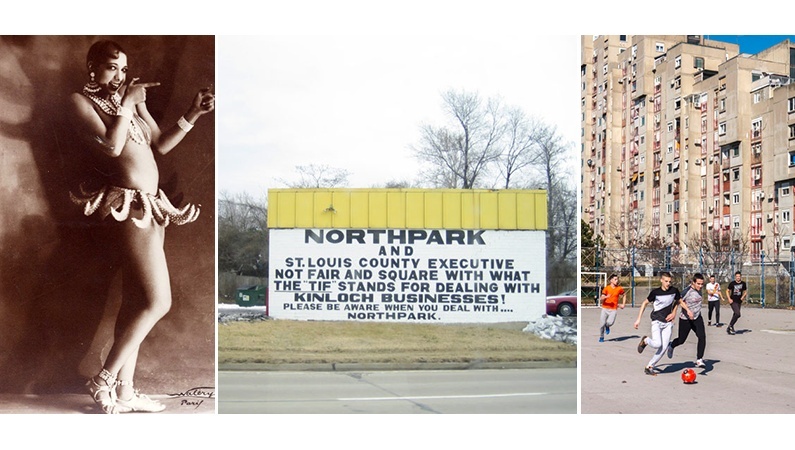2021 Divided City Faculty Collaborative Grant Winners
2021-05-07 • Sam Fox School

(from left) Images representing proposals from Sam Fox School faculty Denise Ward-Brown, Patty Heyda, and Michael Allen.
The Divided City announced the recipients of the 2020-2021 Faculty Collaborative Grants, which included Sam Fox School faculty members Michael Allen, Patty Heyda, and Denise Ward-Brown.
This year, the organization awarded multiple grants of up to $20,000 in support of collaborative research, field institutes, and community engagement on urban segregation broadly conceived. The funding opportunity was open to senior lecturers, professors of the practice, and tenure-track and tenured faculty.
Mass Housing in the United States and Yugoslavia: Crossing the Transatlantic Divide
Michael Allen, senior lecturer in Architecture, Landscape Architecture, and Urban Design (Sam Fox School); lecturer in American Culture Studies (Arts & Sciences)
Vladana Putnik Prica, University of Belgrade
Mass Housing in the United States and Yugoslavia fills a scholarly gap by studying mass housing projects of the Cold War Period from a comparative, transatlantic perspective that includes both capitalist and socialist contexts, that is, cities in the United States and Yugoslavia, respectively. In each of these spaces, the collaborators argue, Modernist architecture took on complex and sometimes coinciding meanings– particularly that of sociopolitical progress– and in the more recent times, became seen as symbols of failed communist ideals. This project seeks out points of contact and divergence between these two ideologically opposed regions, such as the public’s Othering of mass housing residents, aesthetic relationships between architects and planners across the transatlantic divide, and how the inhabitants living in such housing projects understood and negotiated the politicized spaces surrounding them. Mass Housing will therefore convene transatlantic scholars from multiple, intersecting disciplines to create dialogue on the public narratives around such projects in the era of their construction, as well as how such narratives have transformed since the Cold War Period, particularly amid contemporary urban phenomena such as gentrification. During their grant period, they will host a number of keynote speakers, a workshop, and symposium on mass housing, all of which will contribute to the compilation of an edited volume on the subject to be published post-2022.
Mobilizing the Middle: A Radical Atlas of Ferguson
Patty Heyda, Associate Professor of Urban Design & Architecture (Sam Fox School)
Z Gorley, ArchCity Defenders
Blake Strode, Arch City Defenders
Mobilizing the Middle studies the dynamics of urban bureaucracy and its entanglements with targeted police violence, disenfranchisement, and impoverishment in the landscape of Ferguson, Missouri, as well as other nearby Northern Municipalities. Using urban planning documents to tell a narrative of the erosion of civil rights in that area, the project contributes a form of “infographic activism,” mapping histories of both redlining and resistance in the first ring suburb where Michael Brown lived before police murdered him in 2014. The project’s collaborators aim to create complex but legible atlases that are accessible to both academics and the general public, a compilation of which will be distributed to community and educational organizations throughout the region. Their maps will illustrate how municipal planning contributes to, or indeed denies, access to basic needs: education, health, mobility, safety from police violence, and full citizenship.
The Land on Which We Dance: Reclaiming Spaces of Black Dance in St. Louis
Denise Ward-Brown, Professor of Art (Sam Fox School)
Joanna Dee Das, Assistant Professor of Performing Arts (Arts & Sciences)
Michael Allen, Senior Lecturer in Architecture, Land Architecture, and Urban Design (Sam Fox School); Lecturer in American Culture Studies (Arts & Sciences)
Kirven Douthit-Boyd, COCA
Heather Beal, Black Repertory Theater of St. Louis
Inspired by the legacy of St. Louis dancer and activist Josephine Baker, The Land on which We Dance, looks to the elusive but vibrant embodied histories of Black life and experience, particularly those from the jazz age. Their research group will create a living monument to lively black dance spaces in Mill Creek Valley and Chestnut Valley during the early 20th century. These spaces were later demolished alongside the African American neighborhoods where they stood in city planning projects that erased their histories, paving them over with bridges, highways, and parking lots. This project will therefore add to the well-known histories of St. Louis’ contributions to musical genres such as jazz, blues, and ragtime by constructing a dance history of the region that reanimates the innovative space-shaping practices of Bakers’ and other black dancers’ bodies. Their dance monument will consist of preliminary footage, expanding upon that produced for the principal investigators’ earlier film, Seeking Josephine Baker: Dancing on the Land (2020), in which WashU students danced at Baker’s birthplace, now a storage facility for Ameren electric. By the end of the grant period, the collaborators will present their new footage and findings in a public symposium and will convene a Working Group to discuss the next phase of the dance monument project.